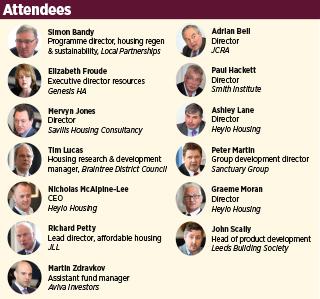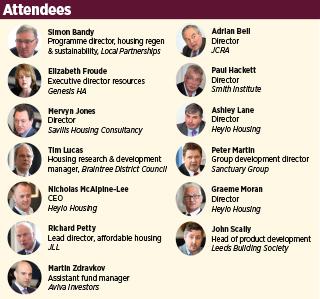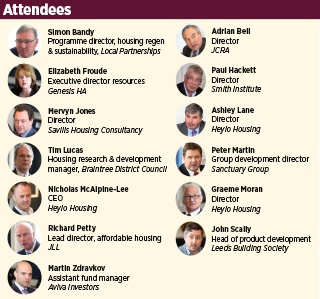Roundtable: Opening the door to more shared ownership
Deciphering the myths and merits of what could be the ‘fourth mainstream tenure’. David Blackman reports.







Source: Belinda Lawley

The last year has transformed the landscape for shared ownership.
Alongside starter homes, it has been the beneficiary of the government’s home ownership masterplan, backed by a £4.1bn funding programme.
However, even after more than two decades of policy support, it remains a relative fringe player in the housing market, accounting for around 170,000 properties in total.
So are market ‘myths’ holding it back? And how can hurdles be overcome to deliver more homes?
Heylo Housing and Social Housing brought together experts from across sectors, including housing associations, lenders, property agents and financial intermediaries, to discuss its future.
Perceptions
Despite last autumn’s largesse, Smith Institute director Paul Hackett describes shared ownership as a ‘Cinderella’ tenure.
‘Home ownership is the number one, number two and number three objective of the government. It’s the tenure that government policy is totally focused on. They talk about shared ownership but only after home ownership.
‘There is such a strong push from central government, providers don’t have many options; you need to make the best of what you have got,’ adds Mr Hackett, who advised John Prescott on housing issues during the last Labour government.
He says: ‘When I was in government, it was very much seen as an opportunity for people in social housing to staircase out but now that’s completely forgotten and it’s part of the debate about home ownership rather than social mobility.’
Simon Bandy, programme director for housing, regeneration and sustainability at Local Partnerships, says that there was often a significant disconnect between the national and regional trends observed by policy makers and the highly granular nature of local housing markets.

Source: Belinda Lawley
‘Inevitably there is an awful lack of understanding about the complete picture in local areas. You can often draw broad conclusions about what is happening in London or the south, but in a lot of the places we work there are massive differences between streets, so you need to have very detailed knowledge.’
He says rather than setting targets for shared ownership homes, it made more sense to assess how the tenure could be used as a tool by social landlords and councils to tackle housing problems in particular areas.
Martin Zdravkov, assistant fund manager at Aviva, agrees that the perception of shared owner occupation has changed: ‘Historically it was looked at from a perspective of a minor extension of social rent while now it’s a major extension of home ownership.’
Just two per cent of new shared ownership purchasers are entering the tenure from social housing, notes Mervyn Jones, head of housing consultancy at Savills.
Peter Martin, director of development at Sanctuary Housing Group, adds that the conversation about the government view is academic and it is ‘up to us to make it work’.
He says that shared ownership remains ‘very much a niche market’ and that competition from other discounted products risks putting it ‘at the back of the queue’. But he also warns against being dismissive of a product without testing the market properly.
Level playing field
To allow shared ownership to flourish, the government needs to level the playing field with starter homes, says Mr Hackett, who has recently completed a study into the tenure’s prospects.
Adrian Bell, head of debt advice and origination at JCRA, says that in some lower value parts of the country it made no sense to build shared ownership properties, citing West Yorkshire as an example. ‘People can buy a three bedroom house in Bradford for £40k. What on earth benefit is there for a social house that will cost £110k to build?’
However in medium demand areas, like those where average prices were around the £150,000 mark, Mr Hackett says shared ownership could take off if it was given a push in the right direction.
One of the problems though, he says, is the government’s failure to fully think through the implications on shared ownership of its drive to incentivise home ownership.
‘With the incentive schemes at the moment, shared ownership gets pushed to the back of the queue,’ he adds.
And while shared ownership has been up and running for more than two decades, it remains a lot less common than other forms of tenure, the roundtable heard.
This presents shared owners with problems when they want to move, says Mr Zdravkov, with a perception that it is difficult to get out of shared ownership unless you staircase fully.
Elizabeth Froude, executive director of resources at Genesis HA, adds that shared ownership is simply less visible than other types of tenure.
‘We need to bring the resale market onto the high street to create a flow in that market,’ she says.
Nicholas McAlpine-Lee, chief executive officer of Heylo, acknowledges that shared ownership remained best understood in London and the South East. He says: ‘The more you move away from there, the less well known it becomes because there’s less volume of properties transacted.’
However, he points to Zoopla for proof that shared ownership had matured. At any point, he says, it is possible to find up to 12,000 shared ownership homes for sale on the website.
Mr Jones describes illiquidity in the shared ownership market as a ‘myth’. His own company’s figures showed that for every two new builds it sold, Savills is trading roughly one second hand shared ownership property.
‘Larger providers like Thames Valley have a very big secondary market under their control,’ he says.
Lender reluctance?
Many at the roundtable felt that lenders’ reluctance to engage with shared ownership had helped to stunt the tenure’s growth.
JLL’s Mr Petty says there are ‘relatively few lenders’ in the shared ownership market.

One problem is that lenders are often unsure about how to assess the risks attached to shared ownership. Tim Lucas, housing research and development manager at Braintree council, says would-be purchasers had been unable to find a lender to provide them with a mortgage at one shared ownership scheme that the Essex authority had helped to bring forward.
‘We had the units sat there and had to convert the scheme to intermediate rent,’ he says.
Mr Scally, head of product development at the Leeds Building Society, says he was unsure about whether it was worth training staff in branches about shared ownership due to the heavily brokered nature of the market.
More than 90 per cent of the lender’s shared ownership business originated from intermediated channels, he says.
But the good news, he adds, was that the arrears profile of shared ownership purchasers is ‘very much’ in line with the society’s typical first time buyer customers.
‘In terms of a risk proposition for a lender, you could argue it’s lower because you have the protection from the lease which you don’t get from the standard residential purchase.’
Mr Jones says one of the reasons for this low delinquency rate is that agents spend a lot of time checking whether potential customers can afford their mortgage and rent payments.
Graeme Moran, a director at Heylo, says lenders might be more interested in engaging if the products were tailored more attractively. He adds: ‘We get very hung up on the product label but if you want to get shared ownership really understood it’s about who the customer is.’
At the other funding end, Mr Bell says financing shared ownership used to be a ‘significant issue’ for HAs. Overall, he says this has fallen away, albeit issues remain surrounding legacy debt, which could lead to repricing if a covenant had to be moved.
‘From an HA point of view it’s been a very good experience and they have made a lot of money out of it. As the property market has gone up they have used a lot of that money to subsidise ordinary social housing,’ he adds.
Mr Petty says there was an underlying tension between the government’s view of shared ownership housing as a tool to promote home ownership and the tenure’s attraction to investors as an annuity-style product.
‘If you look back pre-crunch, shared ownership was generating healthy surpluses,’ he says. But he adds a drop off in the pace of staircasing over recent years had altered how it was perceived by investors.
‘The nature of shared ownership has changed in terms of where it sits in portfolios. If the covenant holds up, it’s a quite attractive asset to hold, which is probably why nobody wants to sell.’
Improving the product
Savills’ Mr Jones outlines a ‘three-point plan’ to encourage the development of a more market-friendly shared ownership.
This includes a relaxation of the 25 per cent lower limit on the stake that would-be shared owners can buy; allowing HAs to charge ground rents on stakes that they retain in older persons’ shared ownership schemes; and encouraging new entrants into the market by getting rid of rules forcing those receiving grants for such properties to publish any expenses.
Ms Froude agrees that a case existed for deregulating the tenure, adding: ‘Some of the rules make it more complex than it needs to be.’
But Mr McAlpine-Lee cautions on the risks of cutting lower limits on stakes.
‘If you make shares too small on lower value properties, you enfranchise lots of people on the teens income bracket and get them on the ladder but then mortgage supply gets really difficult because it’s very costly.’
Another factor that could whet lenders’ appetite is the prospect of increased volumes of shared ownership properties resulting from the government’s decision to increase delivery of the tenure, argues Savills’ Mr Jones.
He says: ‘If I was a retail lender, I would not join a market for 175,000 units over 30 years. But now with the prospect of 135,000 homes over four years I might do it.’
Mr Scally adds that a simplification of shared ownership products could help too.
He says: ‘From a lending perspective, simplicity is good and complexity isn’t. There are around 16 different products at the moment. If you take Help to Buy as a benchmark, there’s one Help to Buy equity product.
Everybody knows and understands it and as a result it works.’
Ashley Lane, who headed the partnerships team at volume housebuilder Persimmon before joining Heylo as a director, says shared ownership providers could also take a leaf out of the volume housebuilders’ book.
‘You could energise the shared ownership market by making it a more retail proposition. When you look at Help to Buy compared to other initiatives, the take up has been absolutely massive,’ he says.
Ms Froude says that Genesis was working closely in partnership with a number of housebuilders on the shared ownership component of schemes.
‘They don’t want to get involved with first time buyers explaining what shared ownership is. They are happy for people like us to do that,’ she adds.
Supply and demand
Sanctuary’s Mr Martin questions whether demand exists to exploit the planned increase in supply of shared ownership properties.
However, he says the Sanctuary approach is to test the market, limit the risk in the same way any commercial company would do and ‘feed back to government what’s happening on the ground’.
There is plenty of appetite for shared ownership housing, provided that the product is tailored in the right way, says Mr McAlpine-Lee, pointing to Heylo’s own recently launched ‘Do It Yourself Shared Ownership’ initiative. Out of 20,000 people emailed at the end of a recent week about the scheme, he says 2,000 people had applied to register by the beginning of the next week.
And the vast majority of those taking shared ownership properties were using the tenure to secure more space than they could afford if they bought outright, particularly families.
He says: ‘This is about busting the myth that people in shared ownership aren’t Generation Rent. They are, but they’re 15 years older and married with kids.’
He adds: ‘If you have bought half of a £200,000 property you have already got a handle on being a shared owner. The likelihood is that your next move will be to a bigger property, not buying the other half of the property you have been living in.
‘We need to collect the data, but it’s about consumer behaviour.’
Mr Jones agrees, noting people don’t tend to live in the same property for life. He suggests it would make sense to offer fixed equity products which could then stimulate a more vibrant resale market for shared ownership properties. However Genesis’ Ms Froude says that in a slow market, shared home owners would be less inclined to move to bigger and more expensive properties.
Affordability
Mr Lucas cautions that shared ownership will not tackle the biggest problem facing his council: the lack of homes for the poorest households and people on job contracts not secure enough to allow them to borrow to access the market.
‘About 30 per cent of the population in the district can’t afford to access the market and our capacity to deal with that is really sorely tested.
‘Twenty per cent of all development is going to be starter homes and it’s difficult to be carried away with the idea that shared ownership will fill the 10 per cent because we are desperate to house people who will otherwise pile up in temporary accommodation.’
But shared ownership could provide a broader stimulus for supply than the conventional owner occupation that the government is so keen on, says Mr McAlpine-Lee.
He says: ‘The fundamental nature of the tenure is that it enfranchises more people than outright purchase. Buying a quarter of a house means that more people can get access to that unit of property.’
Mr Hackett agrees, adding: ‘Maybe this is the time shared ownership will come to fruition.’
RELATED